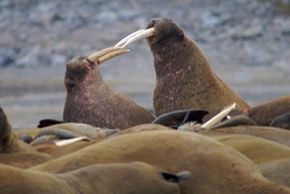Quck answer
Walruses are large marine mammals that live in the Arctic Ocean and adjacent seas. They are known for their long tusks, which are actually elongated canine teeth that can grow up to 3 feet in length. Walruses use their tusks to help them climb onto ice floes and to defend themselves from predators. They also have thick blubber that helps them stay warm in the cold Arctic waters. Walruses are social animals and often gather in large groups, or “haulouts,” on land or ice. They primarily feed on clams and other mollusks, which they locate using their sensitive whiskers. Unfortunately, walruses are facing threats from climate change and overhunting, making conservation efforts crucial for their survival.
Wild Animals
Introduction

Walruses are long-living animals that have few predators, except for killer whales and polar bears. The males and females live apart in separate herds. Females stay with the same herd throughout their lives, while males leave their birth herd after two to three years to join the male herd.
Migration Patterns
Female Pacific walruses migrate annually in herds. They head north to the Chuckchi Sea in summer when the ice melts and recedes. They return south to the Bering Sea before the ice freezes in the winter. Researchers aren’t entirely sure why males don’t migrate as much as females, but some speculate it may be related to sperm production. Little is known about the migration patterns of the Atlantic walrus; they seem to stay in the same general area year-round.
Reproduction
Male walruses usually reach sexual maturity at around age eight to 10, while females mature at five to six years old. Males do not usually mate until around age 15, and females don’t begin mating until age 10.
Pacific walruses mate between December and March. Females only mate once every two years or more due to their long gestation period of 15 months. Thus, females who are still pregnant from the previous breeding season separate from the others when the mating ritual begins.
The males use their pharyngeal muscles to remain upright in the water and begin to serenade the females. They clack their teeth, whistle and make bell sounds until a female is impressed enough to enter the water to mate. Dominance in the male herds is established by body size, tusk size and aggressiveness.
Cows are very protective of their young and even form nursery herds with other mothers. They nurse their calves for up to two years depending on whether they get pregnant again the following year. Cows often give their young rides on their backs even though calves can usually swim after just one month.

Walruses are fascinating animals with unique behaviors and reproductive patterns. They have adapted to life in the Arctic and have few natural predators. Females migrate annually, while males live in separate herds. Their mating rituals involve the males serenading the females until they are impressed enough to mate. Cows are very protective of their young and form nursery herds with other mothers. Overall, walruses are a fascinating species that continue to intrigue researchers and wildlife enthusiasts alike.
When walrus calves are born, they are not small bundles. They weigh between 99 to 165 pounds (45 kg-75 kg) and grow 4 to 6 inches (10-15 centimeters) every month. They gain 1.5 to 2 pounds (0.7 kg-0.9 kg) a day. Walrus calves are usually darker in color than the adults and their color lightens as they age. Although walruses seem harmless, hunters have killed many of them, causing their overall population to decrease. Find out more on the following page.
FAQ
1. What are walruses?
Walruses are large marine mammals that belong to the pinniped family, which also includes seals and sea lions. They are known for their distinctive appearance, with their long tusks and thick blubber layer, which helps them survive in the Arctic environment they call home.
2. How do walruses hunt?
Walruses primarily hunt for clams, mollusks, and other bottom-dwelling creatures by using their sensitive whiskers to locate their prey on the ocean floor. They then use their suction cup-like lips to create a vacuum and suck the prey out of its shell.
3. What are walrus tusks used for?
Walrus tusks are actually elongated canine teeth that can grow up to three feet long. They are used for a variety of purposes, including helping the walrus climb out of the water onto ice floes, breaking through ice to create breathing holes, and fighting with other walruses for territory or mates.
4. How do walruses communicate?
Walruses are highly social animals and use a variety of vocalizations, including grunts, whistles, and bellows, to communicate with one another. They also rely on body language, such as head movements and posturing, to convey their intentions to other members of their group.
5. What threats do walruses face?
Walruses are facing a number of threats, including habitat loss due to climate change, hunting by humans, and oil and gas exploration in their Arctic home. Additionally, pollution and noise from shipping and other human activities can disrupt their communication and feeding behaviors.
6. How do walruses stay warm in the cold Arctic waters?
Walruses have a thick layer of blubber that helps insulate them from the cold water. They also have a specialized circulatory system that allows them to redirect warm blood to their extremities, keeping their flippers and tusks from freezing in the frigid Arctic environment.
7. What is the lifespan of a walrus?
Walruses can live up to 40 years in the wild, although the average lifespan is typically shorter. Females tend to live longer than males, and the oldest recorded walrus was estimated to be over 40 years old.





Leave a Reply